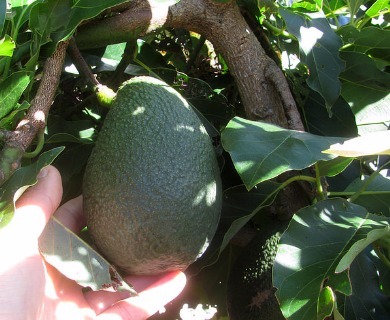Avocado
Persea americana
Bay/Avocado family (Lauraceae)
Post-Cook introduction
Avocado, the well-known tree planted also in forests and sometimes growing as if wild, is known by its shiny yellow green pear-shaped or nearly round about 4–5 inches (10–13 ) long and 3–4 inches (7.5–10 ) in diameter, with oily green and yellow edible flesh somewhat like butter and with very large egg-shaped seed.

©2014 Forest And Kim Starr
Leaves crowded near the ends of twigs, with yellow green leaf-stalks 1⁄2–1 1⁄4 inches (1.3–3 ) long. Blades slightly aromatic when crushed, elliptical, 3 1⁄2–7 inches (9–18 ) long and 2–3 1⁄2 inches (5–9 ) broad, long- or short-pointed at and short-pointed at base, without teeth on edges, slightly thickened, upper surface green to dark green, slightly shiny, hairless or nearly so, and lower surface dull gray green, finely hairy on veins.
Flower clusters () many, branched near the ends of twigs and shorter than leaves. Flowers many on short hairy stalks, greenish yellow, about 3⁄8 inch (1 ) broad, composed of six widely spreading greenish yellow narrow hairy about 3⁄16 inch (5 ) long, 9 greenish yellow more than 1⁄8 inch (3 ) long and three smaller sterile (), and a whitish green with one-celled one-ovuled and slender Flowering when trees are leafless or nearly so.
(berries) borne singly, heavy, hanging down and bending twigs, with leathery skin and thick edible soft flesh somewhat like butter. Seed egg-shaped, about 2–2 1⁄4 inches (5–6 ) long and to 2 inches (5 ) in diameter, with thin brown skin, bitter.
Sapwood is wide, cream-colored and heartwood light reddish brown. Wood moderately soft, lightweight ( gr. 0.45), easy to work, not durable, susceptible to attack by dry-wood termites. Seldom used because the tree is valued for its
The nutritious are eaten raw as a vegetable or salad and are available in the stores of Hawaii virtually year-round from local sources and California. Hogs, other domestic animals, and wild animals are fond of the Commercial oils that can be used as a substitute for olive oil or as an oil for the hair have been extracted from the pulp, which has an oil content of about 5–25 percent. The seeds yield a reddish brown dye for marking clothing. Some parts of the plant, such as leaves, seeds, rind, and bark, have been employed in folk medicines. The fragrant flowers are attractive to bees and make this tree a honey plant. Many races, varying in size, shape, color, and quality of and time of ripening, are in cultivation in Hawaii. Propagation is from seed or, for superior varieties, by budding.
Planted as a tree in moist lowlands of Hawaii to about 1600 ft (488 ) altitude, it is also about houses and naturalizes locally in lower forest and along roadsides. More than 57,000 trees have been planted in the Forest Reserves of all islands by the Division of Forestry and Wildlife, so it really is now a “forest” tree as well as an orchard tree. There are large stands in the Honuliuli and Nanakuli Forest Reserves on Oahu, and many trees may be seen along Tantalus Drive, growing in a forest situation.
Champion
Height 65 ft (19.8 ), c.b.h. 13.8 ft (4.2 ), spread 40 ft (12.2 ). Hawaiian Agricultural Co., Pahala, Hawaii (1968).
Range
Native of Mexico, Guatemala, and Honduras. Widely cultivated as a tree and naturalized in tropical and subtropical regions. Grown in commercial orchards in southern Florida and southern California and naturalized locally in the former. Also, Puerto Rico and Virgin Islands.
Other common names
alligator-pear; aguacate (Spanish); pear, apricot (Virgin Islands); alageta (Guam); bata (Palau)
Introduced into Hawaii in the early part of the 19th century, according to Degener, probably by Don Marin. Not common till after several later attempts some years later, but by 1910 one of the most common trees in lowland gardens. Many improved varieties and hybrids are grown, maturing at different times. The main flowering season is from January to April and the fruiting period from June to August. However, in Hawaii, there are so many varieties that some are in throughout the year. Harvests are heavier in years.




